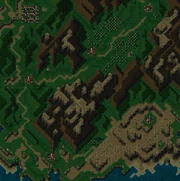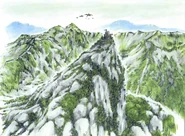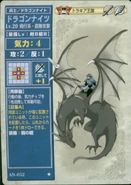
Thracia as depicted in Chapter 9 of Genealogy of the Holy War.
Thracia (トラキア王国, Torakia Ōkoku, lit. Kingdom of Thracia) is a mountainous nation occupying the southern half of the Thracian Peninsula, south of the Munster District. It was founded by the Crusader Dáinn, the older brother of the Crusader Njörun. At the onset of the series, Travant is king of Thracia.
Geography[]
Thracia is the most southeastern country of Jugdral, being directly south of the Munster District. The castle of Meath is located in northern Thracia, the castle of Kapathogia is located in central Thracia, the castle of Luthecia is located in western Thracia, the castle of Grutia is located in southern Thracia, and the eponymous capital city, Thracia, is located in southeastern Thracia.
Because of the region's rocky soil and hilly terrain, food is scarce and the people are often hungry. Thracians have tried many times over Jugdral's history to conquer the fertile Munster District in order to provide food for their families, but all of the major assaults have been repelled by Leonster's lance knight brigade, the Lance Ritter, colloquially known as the "Wall of Leonster", especially by the Thracians.
However, Thracia is the nation that ridable-sized dragons are native to. Thracian knights who ride the dragons are famous as mercenaries throughout Jugdral, and contribute substantially to the country's income.
History[]
The Kingdom of Thracia was founded around the same time the Kingdom of Grannvale, around the time of the Gran Calendar Year 649. The kings of Thracia are descendants of the Crusader Dáinn, who had the lance Gungnir bestowed upon him during the Miracle of Darna. As such, the kings of Thracia are the rightful owners of the lance. Since the kingdom's creation, it has tried to overthrow the Munster District. However, the "Wall of Leonster" successfully repelled their consecutive invasions.
Thracia's mountainous, arid environment made it immensely difficult to grow food there, and as a result, starvation and poverty are rampant in the kingdom. The kingdom resorts to using its infamous Dracoknights as mercenaries to feed its people. In the events of chapter 3 of Genealogy of the Holy War, a squad of Dracoknights are hired by King Chagall of Agustria to defend his last bastion, Castle Silvail, against Sigurd's army. King Travant was in Agustria at the time, watching over his soldiers, but not participating. He returns back to Thracia upon the defeat of the dracoknights, leaving Chagall and Agustria to their fate.
The Dracoknights of Thracia are encountered again in Chapter 5. In the year 761, Quan, having learned about Sigurd's daring return to Grannvale after being exiled and branded a traitor, decides to support his brother-in-law and friend. He takes half of the Lance Ritter, and begins marching towards Grannvale. Ethlyn insisted on joining her husband, and brought their daughter Altena along with them, who was only an infant at the time. Although travelling through the Aed Desert was a risk due to how terribly it'll slow down the army's horses, it was the fastest route to Grannvale. King Travant learns of this mission, and decides to personally confront Quan's army in the desert. Thracia's Dracoknights made short work of Leonster's crippled Lance Ritter. This event became known as the Aed Massacre, and would ensure that the balance of powers in the Thracian Peninsula is shifted.
Thus Thracia is able to successfully invade and subdue the Munster District completely under the reign of King Travant during the Gran Calendar Year 762, in which King Calf of Leonster was killed and betrayed by Raydrik of Conote during the Battle of River Thracia. This victory is short-lived, however, as the Grannvale Empire, under Arvis' rule, would invade the Munster District and claim it for itself, effectively meaning Thracia gained nothing. With no fertile Munster lands to feed his people, and with the Grannvale Empire being too powerful to challenge, King Travant had no choice but to make peace, returning to his kingdom again to bide his time.
Nearly 17 years later, The Liberation Army, headed by Seliph, invades the Munster District to rescue Leif, Nanna, and Finn, as they rebel against Grannvale and House Friege, who currently control Munster. Bloom of Friege is defeated by the liberation army and finally killed, once again shifting the balance in the peninsula. King Travant, having pretended to be an ally of Grannvale's for so long, was waiting for this moment, and finally attempts to reinvade the Munster District to retake it from both Grannvale and the Liberation Army. To guarantee the safety of Munster, and distrusting Thracia's loyalties, Seliph decides to invade Thracia. Altena challenges Seliph's armies, but after an encounter with Leif, learns the truth about herself, and joins the liberation army, which costs Thracia the power of the Gáe Bolg. King Travant leads a valiant attack against the invading forces, but after having given the lance Gugnir to his son, Prince Arion, dies in battle. Prince Arion leads a final three-pronged strike to reclaim his kingdom, called the "Three-Headed Dragon". But even with the full might of Thracia's dracoknights raining down on his army, Seliph still prevails, but Arion is spared from death by Emperor Julius, who teleports him to the safety of Belhalla to continue the fight.
In the epilogue, Arion's dracoknights once again appear, attempting to crush Seliph's army between themselves and the armies of Belhalla. Altena can speak to Arion to convince him to ally himself with Seliph. He and his forces follow Altena. If he dies in battle (or if Altena does not speak to him and Seliph's forces kill him) the royal line of Thracia ends.
After Seliph's army defeats the Grannvale Empire, his cousin Prince Leif of Leonster, with the assistance of his sister Princess Altena and Travant's son Arion, successfully merges the Munster District and Thracia into the New Kingdom of Thracia and becomes king. General Hannibal, the Shield of Thracia, also returns to assist in rebuilding the kingdom. In Thracia 776, Arion is said to have been wounded in the final battle, sidelining him from rebuilding.
Family Tree[]
Characters from Thracia[]
Royal Family of Thracia[]
- Travant - The king of Thracia, and descendant of the crusader Dáinn who hatches a plan to unite the entire peninsula, eying the fertile land to his north.
- Arion - Prince of Thracia, son of Travant
- Altena - Princess of Thracia, daughter of Quan and Ethlyn, and inheritor of the Gáe Bolg who was raised by Travant.
Military[]
- Hannibal - The "Shield of Thracia", a famous general of Thracia, adoptive father of Coirpre
- Kanatz - Hannibal's vassal
- Eda - A Dragon Knight of Thracia, the sister of Dean
- Dean - A Dragon Knight of Thracia, leaves the Thracian army under Arion's orders to protect Linoan, brother of Eda
- Magorn - Assisted Travant in the Aed Massacre
- Papilio - Commander hired by Chagall to fight Sigurd
- Coruta - Knight that tried to seize Munster
- Maikov - General under Travant defending Meath Castle
- Disler - Travant's trusted confidant
Miscellaneous[]
- Coirpre - Adopted son of Hannibal, in fact the son of Sylvia
- Mount Violdrake Bandits - Bandit organization
- Dandelion Bandits - A group of thieves based in the Forest of Dakia
- Lifis Pirates - A pirate group that terrorizes the eastern coast
Etymology[]
The name 'Thracia' came from a province of the Roman Empire, founded around 46 AD. Thracians were considered barbaric. The first historic record about Thracia is found in The Iliad, by Homer. In The Iliad Thracians are allies of the Trojans during the Trojan War. During the era of the Byzantine Empire, the name 'Thracia' was changed to 'Thrace.' Modern Thrace is split between the countries of Bulgaria, Greece and Turkey and holds the city of Istanbul.
Trivia[]
- "Thracian" is the word used to describe people and things from Thracia.
- According to a roundtable interview with Shouzou Kaga, the culture of Thracia is inspired by that of Spain, with the Thracian Peninsula taking reference from Romance cultures in general.[1]













